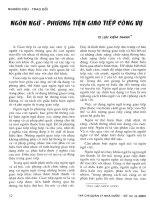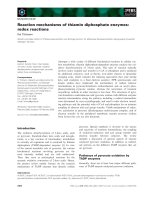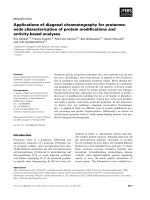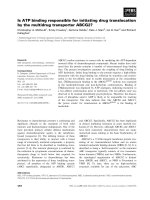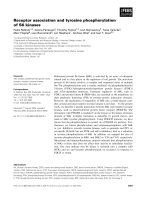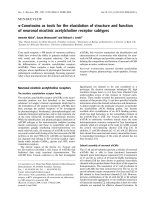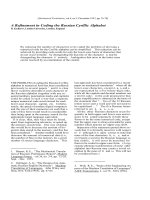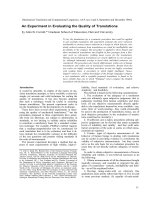Tài liệu Báo cáo khoa học: "Fast Online Lexicon Learning for Grounded Language Acquisition" pdf
Bạn đang xem bản rút gọn của tài liệu. Xem và tải ngay bản đầy đủ của tài liệu tại đây (518.72 KB, 10 trang )
Proceedings of the 50th Annual Meeting of the Association for Computational Linguistics, pages 430–439,
Jeju, Republic of Korea, 8-14 July 2012.
c
2012 Association for Computational Linguistics
Fast Online Lexicon Learning for Grounded Language Acquisition
David L. Chen
Department of Computer Science
The University of Texas at Austin
1616 Guadalupe, Suite 2.408
Austin, TX 78701, USA
Abstract
Learning a semantic lexicon is often an impor-
tant first step in building a system that learns
to interpret the meaning of natural language.
It is especially important in language ground-
ing where the training data usually consist of
language paired with an ambiguous perceptual
context. Recent work by Chen and Mooney
(2011) introduced a lexicon learning method
that deals with ambiguous relational data by
taking intersections of graphs. While the al-
gorithm produced good lexicons for the task of
learning to interpret navigation instructions, it
only works in batch settings and does not scale
well to large datasets. In this paper we intro-
duce a new online algorithm that is an order
of magnitude faster and surpasses the state-
of-the-art results. We show that by changing
the grammar of the formal meaning represen-
tation language and training on additional data
collected from Amazon’s Mechanical Turk we
can further improve the results. We also in-
clude experimental results on a Chinese trans-
lation of the training data to demonstrate the
generality of our approach.
1 Introduction
Learning to understand the semantics of human lan-
guages has been one of the ultimate goals of natural
language processing (NLP). Traditional learning ap-
proaches have relied on access to parallel corpora of
natural language sentences paired with their mean-
ings (Mooney, 2007; Zettlemoyer and Collins, 2007;
Lu et al., 2008; Kwiatkowski et al., 2010). How-
ever, constructing such semantic annotations can be
difficult and time-consuming. More recently, there
has been work on learning from ambiguous super-
vision where a set of potential sentence meanings
are given, only one (or a small subset) of which are
correct (Chen and Mooney, 2008; Liang et al., 2009;
Bordes et al., 2010; Chen and Mooney, 2011). Given
the training data, the system needs to infer the cor-
recting meaning for each training sentence.
Building a lexicon of the formal meaning repre-
sentations of words and phrases, either implicitly
or explicitly, is usually an important step in infer-
ring the meanings of entire sentences. In particu-
lar, Chen and Mooney (2011) first learned a lexicon
to help them resolve ambiguous supervision of re-
lational data in which the number of choices is ex-
ponential. They represent the perceptual context as
a graph and allow each sentence in the training data
to align to any connected subgraph. Their lexicon
learning algorithm finds the common connected sub-
graph that occurs with a word by taking intersections
of the graphs that represent the different contexts in
which the word appears. While the algorithm pro-
duced a good lexicon for their application of learn-
ing to interpret navigation instructions, it only works
in batch settings and does not scale well to large
datasets. In this paper we introduce a novel online
algorithm that is an order of magnitude faster and
also produces better results on their navigation task.
In addition to the new lexicon learning algorithm,
we also look at modifying the meaning representa-
tion grammar (MRG) for their formal semantic lan-
guage. By using a MRG that correlates better to the
structure of natural language, we further improve the
performance on the navigation task. Since our al-
430
gorithm can scale to larger datasets, we present re-
sults on collecting and training on additional data
from Amazon’s Mechanical Turk. Finally, we show
the generality of our approach by demonstrating our
system’s ability to learn from a Chinese translation
of the training data.
2 Background
A common way to learn a lexicon across many dif-
ferent contexts is to find the common parts of the for-
mal representations associated with different occur-
rences of the same words or phrases (Siskind, 1996).
For graphical representations, this involves find-
ing the common subgraph between multiple graphs
(Thompson and Mooney, 2003; Chen and Mooney,
2011). In this section we review the lexicon learning
algorithm introduced by Chen and Mooney (2011)
as well as the overall task they designed to test se-
mantic understanding of navigation instructions.
2.1 Navigation Task
The goal of the navigation task is to build a sys-
tem that can understand free-form natural-language
instructions and follow them to move to the in-
tended destination (MacMahon et al., 2006; Shimizu
and Haas, 2009; Matuszek et al., 2010; Kollar et
al., 2010; Vogel and Jurafsky, 2010; Chen and
Mooney, 2011). Chen and Mooney (2011) de-
fined a learning task in which the only supervi-
sion the system receives is in the form of observ-
ing how humans behave when following sample
navigation instructions in a virtual world. For-
mally, the system is given training data in the
form: {(e
1
, a
1
, w
1
), (e
2
, a
2
, w
2
), . . . , (e
n
, a
n
, w
n
)},
where e
i
is a written natural language instruction, a
i
is an observed action sequence, and w
i
is a descrip-
tion of the virtual world. The goal is then to build a
system that can produce the correct a
j
given a pre-
viously unseen (e
j
, w
j
) pair.
Since the observed actions a
i
only consists of
low-level actions (e.g. turn left, turn right, walk for-
ward) and not high-level concepts (e.g. turn your
back against the wall and walk to the couch), Chen
and Mooney first use a set of rules to automatically
construct the space of reasonable plans using the ac-
tion trace and knowledge about the world. The space
is represented compactly using a graph as shown in
Figure 1: Examples of landmarks plans constructed by
Chen and Mooney (2011) and how they computed the in-
tersection of two graphs.
Figure 1. This is what they called a landmarks plan
and consists of the low-level observed actions in-
terleaved with verification steps indicating what ob-
jects should be observed after each action.
Given that these landmarks plans contain a lot of
extraneous details, Chen and Mooney learn a lexicon
and use it to identify and remove the irrelevant parts
of the plans. They use a greedy method to remove
nodes from the graphs that are not associated with
any of the words in the instructions. The remain-
ing refined landmarks plans are then treated as su-
pervised training data for a semantic-parser learner,
KRISP (Kate and Mooney, 2006). Once a seman-
tic parser is trained, it can be used at test time to
transform novel instructions into formal navigation
plans which are then carried out by a virtual robot
(MacMahon et al., 2006).
2.2 Lexicon Learning
The central component of the system is the lexi-
con learning process which associates words and
short phrases (n-grams) to their meanings (con-
nected graphs). To learn the meaning of an n-gram
w, Chen and Mooney first collect all navigation
plans g that co-occur with w. This forms the ini-
tial candidate meaning set for w. They then repeat-
edly take the intersections between the candidate
meanings to generate additional candidate mean-
ings. They use the term intersection to mean a max-
imal common subgraph (i.e. it is not a subgraph of
any other common subgraphs). In general, there are
431
multiple possible intersections between two graphs.
In this case, they bias toward finding large connected
components by greedily removing the largest com-
mon connected subgraph from both graphs until the
two graphs have no overlapping nodes. The out-
put of the intersection process consists of all the re-
moved subgraphs. An example of the intersection
operation is shown in Figure 1.
Once the list of candidate meanings are generated,
they are ranked by the following scoring metric for
an n-gram w and a graph g:
Score(w, g) = p(g|w) − p(g|¬w)
Intuitively, the score measures how much more
likely a graph g appears when w is present compared
to when it is not. The probabilities are estimated by
counting how many examples contain the word w or
graph g, ignoring multiple occurrences in a single
example.
3 Online Lexicon Learning Algorithm
While the algorithm presented by Chen and Mooney
(2011) produced good lexicons, it only works in
batch settings and does not scale well to large
datasets. The bottleneck of their algorithm is the in-
tersection process which is time-consuming to per-
form. Moreover, their algorithm requires taking
many intersections between many different graphs.
Even though they use beam-search to limit the size
of the candidate set, if the initial candidate meaning
set for a n-gram is large, it can take a long time to
take just one pass through the list of all candidates.
Moreover, reducing the beam size could also hurt the
quality of the lexicon learned.
In this section, we present another lexicon learn-
ing algorithm that is much faster and works in an on-
line setting. The main insight is that most words or
short phrases correspond to small graphs. Thus, we
concentrate our attention on only candidate mean-
ings that are less than a certain size. Using this con-
straint, we generate all the potential small connected
subgraphs for each navigation plan in the training
examples and discard the original graph. Pseudo-
code for the new algorithm, Subgraph Generation
Online Lexicon Learning (SGOLL) algorithm, is
shown in Algorithm 1.
As we encounter each new training example
which consists of a written navigation instruction
Algorithm 1 S UBGRAPH GENERATION ONLINE
LEXICON LEARNING (SGOLL)
input A sequence of navigation instructions
and the corresponding navigation plans
(e
1
, p
1
), . . . , (e
n
, p
n
)
output Lexicon, a set of phrase-meaning pairs
1: main
2: for training example (e
i
, p
i
) do
3: Update((e
i
, p
i
))
4: end for
5: OutputLexicon()
6: end main
7:
8: function Update(training example (e
i
, p
i
))
9: for n-gram w that appears in e
i
do
10: for connected subgraph g of p
i
such that
the size of g is less than or equal to m do
11: Increase the co-occurrence count of g
and w by 1
12: end for
13: end for
14: Increase the count of examples, each n-gram
w and each subgraph g
15: end function
16:
17:
18: function OutputLexicon()
19: for n-gram w that has been observed do
20: if Number of times w has been observed is
less than minSup then
21: skip w
22: end if
23: for subgraph g that has co-occurred with w
do
24: if score(w, g) > threshold t then
25: add (w, g) to Lexicon
26: end if
27: end for
28: end for
29: end function
432
and the corresponding navigation plan, we first seg-
ment the instruction into word tokens and construct
n-grams from them. From the corresponding navi-
gation plan, we find all connected subgraphs of size
less than or equal to m. We then update the co-
occurrence counts between all the n-grams w and
all the connected subgraphs g. We also update the
counts of how many examples we have encountered
so far and counts of the n-grams w and subgraphs
g. At any given time, we can compute a lexicon
using these various counts. Specifically, for each
n-gram w, we look at all the subgraphs g that co-
occurred with it, and compute a score for the pair
(w, g). If the score is higher than the threshold t, we
add the entry (w, g) to the lexicon. We use the same
scoring function as Chen and Mooney, which can be
computed efficiently using the counts we keep. In
contrast to Chen and Mooney’s algorithm though,
we add the constraint of minimum support by not
creating lexical entries for any n-gram w that ap-
peared in less than minSup training examples. This
is to prevent rarely seen n-grams from receiving high
scores in our lexicon simply due to their sparsity.
Unless otherwise specified, we compute lexical en-
tries for up to 4-grams with threshold t = 0.4, max-
imum subgraph size m = 3, and minimum support
minSup = 10.
It should be noted that SGOLL can also become
computationally intractable if the sizes of the nav-
igations plans are large or if we set the maximum
subgraph size m to a large number. Moreover, the
memory requirement can be quite high if there are
many different subgraphs g associated with each n-
gram w. To deal with such scalability issues, we
could use beam-search and only keep the top k can-
didates associated with each w. Another important
step is to define canonical orderings of the nodes in
the graphs. This allows us to determine if two graphs
are identical in constant time and also lets us use a
hash table to quickly update the co-occurrence and
subgraph counts. Thus, even given a large number
of subgraphs for each training example, each sub-
graph can be processed very quickly. Finally, this
algorithm readily lends itself to being parallelized.
Each processor would get a fraction of the training
data and compute the counts individually. Then the
counts can be merged together at the end to produce
the final lexicon.
3.1 Changing the Meaning Representation
Grammar
In addition to introducing a new lexicon learning
algorithm, we also made another modification to
the original system proposed by Chen and Mooney
(2011). To train a semantic parser using KRISP
(Kate and Mooney, 2006), they had to supply a
MRG, a context-free grammar, for their formal nav-
igation plan language. KRISP learns string-kernel
classifiers that maps natural language substrings to
MRG production rules. Consequently, it is impor-
tant that the production rules in the MRG mirror the
structure of natural language (Kate, 2008).
The original MRG used by Chen and Mooney is a
compact grammar that contains many recursive rules
that can be used to generate an infinite number of ac-
tions or arguments. While these rules are quite ex-
pressive, they often do not correspond well to any
words or phrases in natural language. To alleviate
this problem, we designed another MRG by expand-
ing out many of the rules. For example, the original
MRG contained the following production rules for
generating an infinite number of travel actions from
the root symbol S.
*
S ->
*
Action
*
Action ->
*
Action,
*
Action
*
Action ->
*
Travel
*
Travel -> Travel( )
*
Travel -> Travel( steps:
*
Num )
We expand out the production rules as shown be-
low to map S directly to specific travel actions so
they correspond better to patterns such as “go for-
ward” or “walk N steps”.
*
S -> Travel( )
*
S -> Travel( steps:
*
Num )
*
S -> Travel( ),
*
Action
*
S -> Travel( steps:
*
Num ),
*
Action
*
Action ->
*
Action,
*
Action
*
Action -> Travel( )
*
Action -> Travel( steps:
*
Num )
While this process of expanding the produc-
tion rules resulted in many more rules, these ex-
panded rules usually correspond better with words
or phrases in natural language. We still retain some
of the recursive rules to ensure that the formal lan-
guage remains as expressive as before.
433
4 Collecting Additional Data with
Mechanical Turk
One of the motivations for studying ambiguous su-
pervision is the potential ease of acquiring large
amounts of training data. Without requiring seman-
tic annotations, a human only has to demonstrate
how language is used in context which is generally
simple to do. We validate this claim by collecting
additional training data for the navigation domain
using Mechanical Turk (Snow et al., 2008).
There are two types of data we are interested in
collecting: natural language navigation instructions
and follower data. Thus, we created two tasks on
Mechanical Turk. The first one asks the workers
to supply instructions for a randomly generated se-
quence of actions. The second one asks the workers
to try to follow a given navigation instruction in our
virtual environment. The latter task is used to gener-
ate the corresponding action sequences for instruc-
tions collected from the first task.
4.1 Task Descriptions
To facilitate the data collection, we first recreated
the 3D environments used to collect the original data
(MacMahon et al., 2006). We built a Java appli-
cation that allows the user to freely navigate the
three virtual worlds constructed by MacMahon et
al. (2006) using the discrete controls of turning left,
turning right, and moving forward one step.
The follower task is fairly straightforward using
our application. The worker is given a navigation
instruction and placed at the starting location. They
are asked to follow the navigation instruction as best
as they could using the three discrete controls. They
could also skip the problem if they did not under-
stand the instruction or if the instruction did not de-
scribe a viable route. For each Human Intelligence
Task (HIT), we asked the worker to complete 5 fol-
lower problems. We paid them $0.05 for each HIT,
or 1 cent per follower problem. The instructions
used for the follower problems were mainly col-
lected from our Mechanical Turk instructor task with
some of the instructions coming from data collected
by MacMahon (2007) that was not used by Chen and
Mooney (2011).
The instructor task is slightly more involved be-
cause we ask the workers to provide new navigation
Chen & Mooney MTurk
# instructions 3236 1011
Vocabulary size 629 590
Avg. # words 7.8 (5.1) 7.69 (7.12)
Avg. # actions 2.1 (2.4) 1.84 (1.24)
Table 1: Statistics about the navigation instruction cor-
pora. The average statistics for each instruction are
shown with standard deviations in parentheses.
instructions. The worker is shown a 3D simulation
of a randomly generated action sequence between
length 1 to 4 and asked to write short, free-form in-
structions that would lead someone to perform those
actions. Since this task requires more time to com-
plete, each HIT consists of only 3 instructor prob-
lems. Moreover, we pay the workers $0.10 for each
HIT, or about 3 cents for each instruction they write.
To encourage quality contributions, we use a
tiered payment structure (Chen and Dolan, 2011)
that rewards the good workers. Workers who have
been identified to consistently provide good instruc-
tions were allowed to do higher-paying version of
the same HITs that paid $0.15 instead of $0.10.
4.2 Data Statistics
Over a 2-month period we accepted 2,884 follower
HITs and 810 instructor HITs from 653 workers.
This corresponds to over 14,000 follower traces and
2,400 instructions with most of them consisting of
single sentences. For instructions with multiple sen-
tences, we merged all the sentences together and
treated it as a single sentence. The total cost of
the data collection was $277.92. While there were
2,400 instructions, we filtered them to make sure
they were of reasonable quality. First, we discarded
any instructions that did not have at least 5 follower
traces. Then we looked at all the follower traces and
discarded any instruction that did not have majority
agreement on what the correct path is.
Using our strict filter, we were left with slightly
over 1,000 instructions. Statistics about the new
corpus and the one used by Chen and Mooney can
be seen in Table 1. Overall, the new corpus has a
slightly smaller vocabulary, and each instruction is
slightly shorter both in terms of the number of words
and the number of actions.
434
5 Experiments
We evaluate our new lexicon learning algorithm as
well as the other modifications to the navigation sys-
tem using the same three tasks as Chen and Mooney
(2011). The first task is disambiguating the train-
ing data by inferring the correct navigation plans as-
sociated with each training sentence. The second
task is evaluating the performance of the semantic
parsers trained on the disambiguated data. We mea-
sure the performance of both of these tasks by com-
paring to gold-standard data using the same partial
correctness metric used by Chen and Mooney which
gives credit to a parse for producing the correct ac-
tion type and additional credit if the arguments were
also correct. Finally, the third task is to complete the
end-to-end navigation task. There are two versions
of this task, the complete task uses the original in-
structions which are several sentences long and the
other version uses instructions that have been man-
ually split into single sentences. Task completion
is measured by the percentage of trials in which the
system reached the correct destination (and orienta-
tion in the single-sentence version).
We follow the same evaluation scheme as Chen
and Mooney and perform leave-one-map-out exper-
iments. For the first task, we build a lexicon using
ambiguous training data from two maps, and then
use the lexicon to produce the best disambiguated
semantic meanings for those same data. For the sec-
ond and third tasks, we train a semantic parser on the
automatically disambiguated data, and test on sen-
tences from the third, unseen map.
For all comparisons to the Chen and Mooney re-
sults, we use the performance of their refined land-
marks plans system which performed the best over-
all. Moreover, it provides the most direct compari-
son to our approach since both use a lexicon to re-
fine the landmarks plans. Other than the modifi-
cations discussed, we use the same components as
their system including using KRISP to train the se-
mantic parsers and using the execution module from
MacMahon et al. (2006) to carry out the navigation
plans.
5.1 Inferring Navigation Plans
First, we examine the quality of the refined naviga-
tion plans produced using SGOLL’s lexicon. The
Precision Recall F1
Chen and Mooney 78.54 78.10 78.32
SGOLL 87.32 72.96 79.49
Table 2: Partial parse accuracy of how well each algo-
rithm can infer the gold-standard navigation plans.
Precision Recall F1
Chen and Mooney 90.22 55.10 68.37
SGOLL 92.22 55.70 69.43
SGOLL with
new MRG 88.36 57.03 69.31
Table 3: Partial parse accuracy of the semantic parsers
trained on the disambiguated navigation plans.
precision, recall, and F1 (harmonic mean of preci-
sion and recall) of these plans are shown in Table 2.
Compared to Chen and Mooney, the plans produced
by SGOLL has higher precision and lower recall.
This is mainly due to the additional minimum sup-
port constraint we added which discards many noisy
lexical entries from infrequently seen n-grams.
5.2 Training Semantic Parsers
Next we look at the performance of the semantic
parsers trained on the inferred navigation plans. The
results are shown in Table 3. Here SGOLL per-
forms almost the same as Chen and Mooney, with
slightly better precision. We also look at the effect of
changing the MRG. Using the new MRG for KRISP
to train the semantic parser produced slightly lower
precision but higher recall, with similar overall F1
score.
5.3 Executing Navigation Plans
Finally, we evaluate the system on the end-to-end
navigation task. In addition to SGOLL and SGOLL
with the new MRG, we also look at augmenting each
of the training splits with the data we collected using
Mechanical Turk.
Completion rates for both the single-sentence
tasks and the complete tasks are shown in Table 4.
Here we see the benefit of each of our modifications.
SGOLL outperforms Chen and Mooney’s system on
both versions of the navigation task. Using the new
MRG to train the semantic parsers further improved
performance on both tasks. Finally, augmenting the
435
Single-sentence Complete
Chen and Mooney 54.40% 16.18%
SGOLL 57.09% 17.56%
SGOLL with new
MRG 57.28% 19.18%
SGOLL with new
MRG and
MTurk data 57.62% 20.64%
Table 4: End-to-end navigation task completion rates.
Computation Time
Chen and Mooney (2011) 2,227.63
SGOLL 157.30
SGOLL with MTurk data 233.27
Table 5: The time (in seconds) it took to build the lexicon.
training data with additional instructions and fol-
lower traces collected from Mechanical Turk pro-
duced the best results.
5.4 Computation Times
Having established the superior performance of our
new system compared to Chen and Mooney’s, we
next look at the computational efficiency of SGOLL.
The average time (in seconds) it takes for each al-
gorithm to build a lexicon is shown in Table 5.
All the results are obtained running the algorithms
on Dell PowerEdge 1950 servers with 2x Xeon
X5440 (quad-core) 2.83GHz processors and 32GB
of RAM. Here SGOLL has a decidedly large advan-
tage over the lexicon learning algorithm from Chen
and Mooney, requiring an order of magnitude less
time to run. Even after incorporating the new Me-
chanical Turk data into the training set, SGOLL still
takes much less time to build a lexicon. This shows
how inefficient it is to perform graph intersection op-
erations and how our online algorithm can more re-
alistically scale to large datasets.
5.5 Experimenting with Chinese Data
In addition to evaluating the system on English data,
we also translated the corpus used by Chen and
Mooney into Mandarin Chinese.
1
To run our sys-
1
The translation can be downloaded at .
utexas.edu/
˜
ml/clamp/navigation/
tem, we first segmented the sentences using the
Stanford Chinese Word Segmenter (Chang et al.,
2008). We evaluated using the same three tasks as
before. This resulted in a precision, recall, and F1
of 87.07, 71.67, and 78.61, respectively for the in-
ferred plans. The trained semantic parser’s preci-
sion, recall, and F1 were 88.87, 58.76, and 70.74, re-
spectively. Finally, the system completed 58.70% of
the single-sentence task and 20.13% of the complete
task. All of these numbers are very similar to the En-
glish results, showing the generality of the system in
its ability to learn other languages.
5.6 Discussion
We have introduced a novel, online lexicon learn-
ing algorithm that is much faster than the one pro-
posed by Chen and Mooney and also performs bet-
ter on the navigation tasks they devised. Having
a computationally efficient algorithm is critical for
building systems that learn from ambiguous super-
vision. Compared to systems that train on super-
vised semantic annotations, a system that only re-
ceives weak, ambiguous training data is expected to
have to train on much larger datasets to achieve sim-
ilar performance. Consequently, such system must
be able to scale well in order to keep the learning
process tractable. Not only is SGOLL much faster in
building a lexicon, it can also be easily parallelized.
Moreover, the online nature of SGOLL allows the
lexicon to be continually updated while the system
is in use. A deployed navigation system can gather
new instructions from the user and receive feedback
about whether it is performing the correct actions.
As new training examples are collected, we can up-
date the corresponding n-gram and subgraph counts
without rebuilding the entire lexicon.
One thing to note though is that while SGOLL
makes the lexicon learning step much faster and
scalable, another bottleneck in the overall system
is training the semantic parser. Existing semantic-
parser learners such as KRISP were not designed to
scale to very large datasets and have trouble training
on more than a few thousand examples. Thus, de-
signing new scalable algorithms for learning seman-
tic parsers is critical to scaling the entire system.
We have performed a pilot data collection of new
training examples using Mechanical Turk. Even
though the instructions were collected from very dif-
436
ferent sources (paid human subjects from a univer-
sity for the original data versus workers recruited
over the Internet), we showed that adding the new
data into the training set improved the system’s per-
formance on interpreting instructions from the orig-
inal corpus. It verified that we are indeed collecting
useful information and that non-experts are fully ca-
pable of training the system by demonstrating how
to use natural language in relevant contexts.
6 Related Work
The earliest work on cross-situational word learning
was by Siskind (1996) who developed a rule-based
system to solve the referential ambiguity problem.
However, it did not handle noise and was tested only
on artificial data. More recently, Fazly et al. (2010)
proposed a probabilistic incremental model that can
learn online similar to our algorithm and was tested
on transcriptions of child-directed speech. However,
they generated the semantic representations from the
text itself rather than from the environment. More-
over, the referential ambiguity was introduced artifi-
cially by including the correct semantic representa-
tion of the neighboring sentence.
Our work falls into the larger framework of learn-
ing the semantics of language from weak supervi-
sion. This problem can be seen as an alignment
problem where each sentence in the training data
needs to be aligned to one or more records that rep-
resent its meaning. Chen and Mooney (2008) previ-
ously introduced another task that aligns sportscast-
ing commentaries to events in a simulated soccer
game. Using an EM-like retraining method, they
alternated between building a semantic parser and
estimating the most likely alignment. Liang et al.
(2009) developed an unsupervised approach using a
generative model to solve the alignment problem.
They demonstrated improved results on matching
sentences and events on the sportscasting task and
also introduced a new task of aligning weather fore-
casts to weather information. Kim and Mooney
(2010) further improved the generative alignment
model by incorporating the full semantic parsing
model from Lu et al. (2008). This resulted in a
joint generative model that outperformed all previ-
ous results. In addition to treating the ambiguous
supervision problem as an alignment problem, there
have been other approaches such as treating it as a
ranking problem (Bordes et al., 2010), or a PCFG
learning problem (Borschinger et al., 2011).
Parallel to the work of learning from ambigu-
ous supervision, other recent work has also looked
at training semantic parsers from supervision other
than logical-form annotations. Clarke et al. (2010)
and Liang et al. (2011) trained systems on question
and answer pairs by automatically finding semantic
interpretations of the questions that would generate
the correct answers. Artzi and Zettlemoyer (2011)
use conversation logs between a computer system
and a human user to learn to interpret the human
utterances. Finally, Goldwasser et al. (2011) pre-
sented an unsupervised approach of learning a se-
mantic parser by using an EM-like retraining loop.
They use confidence estimation as a proxy for the
model’s prediction quality, preferring models that
have high confidence about their parses.
7 Conclusion
Learning the semantics of language from the per-
ceptual context in which it is uttered is a useful ap-
proach because only minimal human supervision is
required. In this paper we presented a novel online
algorithm for building a lexicon from ambiguously
supervised relational data. In contrast to the pre-
vious approach that computed common subgraphs
between different contexts in which an n-gram ap-
peared, we instead focus on small, connected sub-
graphs and introduce an algorithm, SGOLL, that is
an order of magnitude faster. In addition to being
more scalable, SGOLL also performed better on the
task of interpreting navigation instructions. In addi-
tion, we showed that changing the MRG and collect-
ing additional training data from Mechanical Turk
further improve the performance of the overall nav-
igation system. Finally, we demonstrated the gener-
ality of the system by using it to learn Chinese navi-
gation instructions and achieved similar results.
Acknowledgments
The research in this paper was supported by the Na-
tional Science Foundation (NSF) under the grants
IIS-0712097 and IIS-1016312. We thank Lu Guo for
performing the translation of the corpus into Man-
darin Chinese.
437
References
Yoav Artzi and Luke Zettlemoyer. 2011. Bootstrapping
semantic parsers from conversations. In Proceedings
of the 2011 Conference on Empirical Methods in Nat-
ural Language Processing (EMNLP-11).
Antoine Bordes, Nicolas Usunier, and Jason Weston.
2010. Label ranking under ambiguous supervision for
learning semantic correspondences. In Proceedings of
the 27th International Conference on Machine Learn-
ing (ICML-2010).
Benjamin Borschinger, Bevan K. Jones, and Mark John-
son. 2011. Reducing grounded learning tasks to gram-
matical inference. In Proceedings of the 2011 Confer-
ence on Empirical Methods in Natural Language Pro-
cessing (EMNLP-11).
Pi-Chuan Chang, Michel Galley, and Chris Manning.
2008. Optimizing Chinese word segmentation for ma-
chine translation performance. In Proceedings of the
ACL Third Workshop on Statistical Machine Transla-
tion.
David L. Chen and William B. Dolan. 2011. Collecting
highly parallel data for paraphrase evaluation. In Pro-
ceedings of the 49th Annual Meeting of the Association
for Computational Linguistics (ACL-2011), Portland,
OR, June.
David L. Chen and Raymond J. Mooney. 2008. Learn-
ing to sportscast: A test of grounded language ac-
quisition. In Proceedings of 25th International Con-
ference on Machine Learning (ICML-2008), Helsinki,
Finland, July.
David L. Chen and Raymond J. Mooney. 2011. Learn-
ing to interpret natural language navigation instruc-
tions from observations. In Proceedings of the 25th
AAAI Conference on Artificial Intelligence (AAAI-11).
James Clarke, Dan Goldwasser, Ming-Wei Chang, and
Dan Roth. 2010. Driving semantic parsing from
the worlds response. In Proceedings of the Four-
teenth Conference on Computational Natural Lan-
guage Learning (CoNLL-2010), pages 18–27.
Afsaneh Fazly, Afra Alishahi, and Suzanne Steven-
son. 2010. A probabilistic computational model of
cross-situational word learning. Cognitive Science,
34(6):1017–1063.
Dan Goldwasser, Roi Reichart, James Clarke, and Dan
Roth. 2011. Confidence driven unsupervised semantic
parsing. In Proceedings of the 49th Annual Meeting of
the Association for Computational Linguistics (ACL-
11).
Rohit J. Kate and Raymond J. Mooney. 2006. Us-
ing string-kernels for learning semantic parsers. In
Proceedings of the 21st International Conference on
Computational Linguistics and 44th Annual Meet-
ing of the Association for Computational Linguis-
tics (COLING/ACL-06), pages 913–920, Sydney, Aus-
tralia, July.
Rohit J. Kate. 2008. Transforming meaning repre-
sentation grammars to improve semantic parsing. In
Proceedings of the Twelfth Conference on Compu-
tational Natural Language Learning (CoNLL-2008),
pages 33–40, Manchester, UK, August.
Joohyun Kim and Raymond J. Mooney. 2010. Genera-
tive alignment and semantic parsing for learning from
ambiguous supervision. In Proceedings of the 23rd In-
ternational Conference on Computational Linguistics
(COLING-10).
Thomas Kollar, Stefanie Tellex, Deb Roy, and Nicholas
Roy. 2010. Toward understanding natural language
directions. In Proceedings of the 5th ACM/IEEE In-
ternational Conference on Human-Robot Interaction
(HRI).
Tom Kwiatkowski, Luke Zettlemoyer, Sharon Goldwa-
ter, and Mark Steedman. 2010. Inducing probabilistic
CCG grammars from logical form with higher-order
unification. In Proceedings of the 2010 Conference on
Empirical Methods in Natural Language Processing
(EMNLP-10).
Percy Liang, Michael I. Jordan, and Dan Klein. 2009.
Learning semantic correspondences with less supervi-
sion. In Joint Conference of the 47th Annual Meeting
of the Association for Computational Linguistics and
the 4th International Joint Conference on Natural Lan-
guage Processing of the Asian Federation of Natural
Language Processing (ACL-IJCNLP).
Percy Liang, Michael I. Jordan, and Dan Klein. 2011.
Learning dependency-based compositional semantics.
In Proceedings of the 49th Annual Meeting of the As-
sociation for Computational Linguistics (ACL-11).
Wei Lu, Hwee Tou Ng, Wee Sun Lee, and Luke S. Zettle-
moyer. 2008. A generative model for parsing natural
language to meaning representations. In Proceedings
of the 2008 Conference on Empirical Methods in Natu-
ral Language Processing (EMNLP-08), Honolulu, HI,
October.
Matt MacMahon, Brian Stankiewicz, and Benjamin
Kuipers. 2006. Walk the talk: Connecting language,
knowledge, and action in route instructions. In Pro-
ceedings of the Twenty-First National Conference on
Artificial Intelligence (AAAI-06).
Matt MacMahon. 2007. Following Natural Language
Route Instructions. Ph.D. thesis, Electrical and Com-
puter Engineering Department, University of Texas at
Austin.
Cynthia Matuszek, Dieter Fox, and Karl Koscher. 2010.
Following directions using statistical machine transla-
tion. In Proceedings of the 5th ACM/IEEE Interna-
tional Conference on Human-Robot Interaction (HRI).
438
Raymond J. Mooney. 2007. Learning for semantic pars-
ing. In A. Gelbukh, editor, Computational Linguistics
and Intelligent Text Processing: Proceedings of the 8th
International Conference, CICLing 2007, Mexico City,
pages 311–324. Springer Verlag, Berlin.
Nobuyuki Shimizu and Andrew Haas. 2009. Learning to
follow navigational route instructions. In Proceedings
of the Twenty-first International Joint Conference on
Artificial Intelligence (IJCAI-2009).
Jeffrey M. Siskind. 1996. A computational study
of cross-situational techniques for learning word-to-
meaning mappings. Cognition, 61(1):39–91, October.
Rion Snow, Brendan O’Connor, Daniel Jurafsky, and An-
drew Y. Ng. 2008. Cheap and fast - but is it good?
evaluating non-expert annotations for natural language
tasks. In Proceedings of the 2008 Conference on
Empirical Methods in Natural Language Processing
(EMNLP-08).
Cynthia A. Thompson and Raymond J. Mooney. 2003.
Acquiring word-meaning mappings for natural lan-
guage interfaces. Journal of Artificial Intelligence Re-
search, 18:1–44.
Adam Vogel and Dan Jurafsky. 2010. Learning to fol-
low navigational directions. In Proceedings of the 48th
Annual Meeting of the Association for Computational
Linguistics (ACL-10).
Luke S. Zettlemoyer and Michael Collins. 2007. Online
learning of relaxed CCG grammars for parsing to logi-
cal form. In Proceedings of the 2007 Joint Conference
on Empirical Methods in Natural Language Process-
ing and Computational Natural Language Learning
(EMNLP-CoNLL-07), pages 678–687, Prague, Czech
Republic, June.
439

